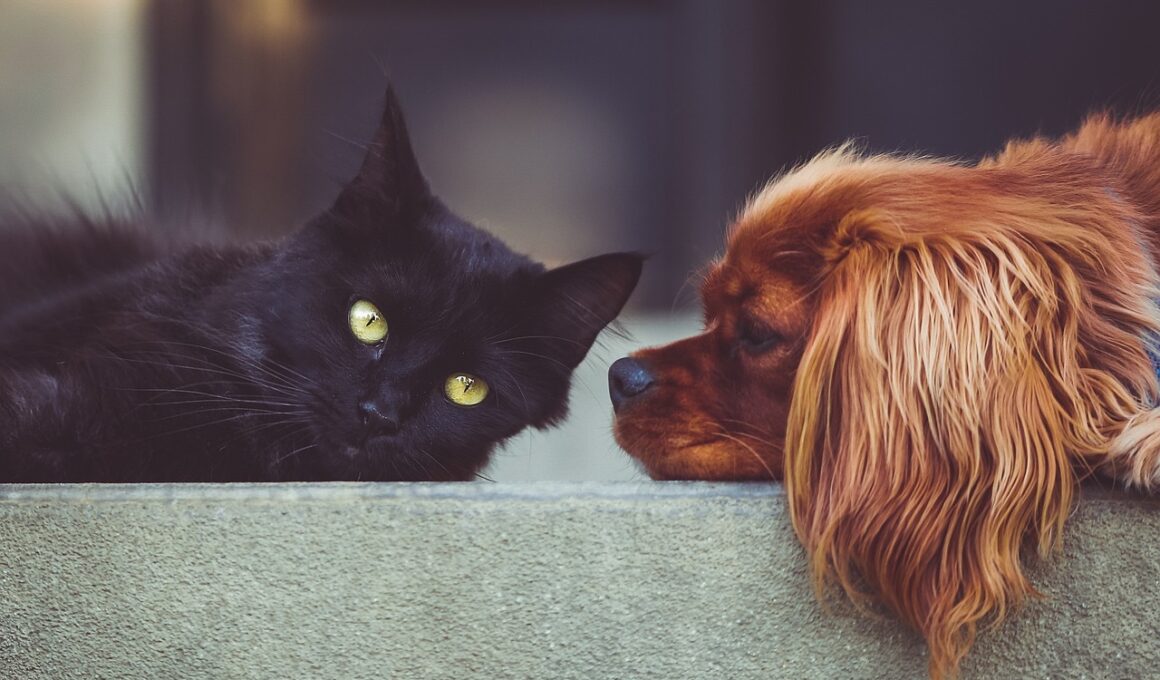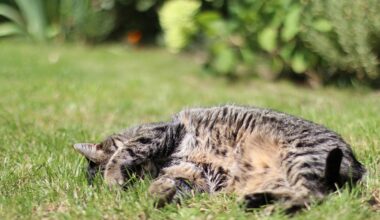Creating Separate Safe Zones for Cats in Multi-Pet Homes
In multi-pet households, creating separate safe zones for cats is essential for ensuring their well-being. Cats can be territorial creatures, and introducing new animals can lead to stress and anxiety. A safe zone allows them to have a designated space where they feel secure and at ease. To achieve this, it is crucial to set up an area that is off-limits to other pets. This can be a separate room or a cozy nook, filled with essentials like a litter box, food, water, and toys. Familiar scents are comforting for cats, so include items that smell like them, such as blankets or favorite toys. It is also important to offer vertical spaces like shelves or cat trees, as these give cats a sense of security while allowing them to observe their surroundings. Make sure to supervise interactions between pets gradually during the introduction phase. This gradual approach can significantly reduce tension, helping both cats and other pets coexist peacefully in the same home. Always keep an attentive eye on body language and stress signs, as early detection can prevent unwanted confrontations.
Establishing a separate zone for your cat fosters their sense of ownership. Each pet can develop their own space, which minimizes direct competition for resources. Ensure that the safe zone is stocked with all necessities: food, water, scratching posts, and cozy bedding. Individual food and water bowls should be provided to avoid conflicts. Consider using puzzle feeders or interactive toys to keep your cat mentally stimulated while they enjoy solitude. In addition, make sure to enrich this zone by providing stimulating activities, like interactive play sessions, to keep them engaged. This allows them to feel fulfilled, reducing the likelihood of behavioral issues stemming from boredom or anxiety. Soft lighting and peaceful sounds can enhance their comfort level in the safe zone. Don’t forget about scents; using calming diffusers with cat-safe pheromones can create a soothing environment. Familiarity with their space can greatly reduce stress levels, indicating a welcomed retreat. Consider the layout of your home, too; ensure that areas leading to the safe zone are easily accessible. This efficiency will help your cat feel more secure and less isolated.
Importance of Gradual Introductions
When introducing new pets, it’s vital to make the transition gradual. Abrupt changes can lead to heightened stress for a cat. Initially, allow the new pet to explore the home while keeping your cat in their safe zone. After a few days, start creating supervised interactions in neutral territory. Monitor their interactions closely, making sure to intervene if either pet exhibits signs of aggression or significant stress. Slowly increase the length of these introductions only when both pets seem comfortable. Each encounter helps them adjust to each other’s presence, building a foundation of trust and reducing anxiety. Additionally, utilize treats and positive reinforcement, rewarding both pets for calm behavior during these meetings. Over time, you can decrease supervision as they grow more familiar with one another. Keep in mind that every cat has a unique personality; some may take longer to adapt than others. Consequently, patience is crucial. Eventually, they may begin to share space more comfortably, reducing territorial disputes as they learn to coexist. Establishing routine and predictability can provide a sense of stability for both pet types.
Incorporating barriers between pets—a baby gate or a screen door—can help them see without direct contact. Cats often feel less threatened when they can observe other animals from a distance. Place items such as treats or toys near the barrier to promote positive associations with each other’s scents. This method can create a safer environment to introduce scents slowly. Through this process, they can become acquainted with each other’s presence before a face-to-face meeting. Also, consider using calming products, such as Feliway sprays or calming collars, to help ease tension. A key strategy is to rotate pets’ access to the shared living areas, so they get accustomed to each other’s scent while maintaining their safe zones. Over time, as they develop familiarity, the introduction becomes smoother. Solo playtime is also important; spend quality time with each pet to reinforce social bonds while making them feel valued. Through these dedicated interactions and strategic management of their environment, cats can thrive, ultimately leading to a more harmonious multi-pet home.
Your Cat’s Mental Well-Being
Cats require mental stimulation just as much as they need physical exercise. Safe zones should be equipped with engaging objects, such as puzzle games or feather toys, catering to their instincts. Use this area to establish a routine that combines playtime with relaxation. Explain to family members the importance of allowing your cat to have their space, teaching children how to respect these boundaries. Reducing stress causes a substantial improvement in your cat’s overall health. Additionally, consult with your veterinarian for recommendations on anxiety reduction techniques specific to your cat’s needs. Socialization and behavior differ significantly among felines, so understanding your cat’s behavior is crucial. Spend time observing your cat’s reactions to different stimuli, including the presence of other pets. Create environments that empower your cat to make choices about their interactions, reinforcing their confidence. Many cats respond positively to interactive play sessions where they can control the flow. Look for opportunities for them to initiate play. Recognizing their preferences allows you to enhance their engagements, strengthening your bond through a shared understanding which leads ultimately to well-adjusted coexistence.
Moreover, don’t forget about their physical health. Regular vet visits are integral for identifying any medical issues that could affect behavior. A healthy cat is more likely to tolerate the presence of other pets. Pay attention to carrier training for vet visits; making it a positive experience can reduce anxiety associated with travel. Monitor food intake, since stress can cause overeating or loss of appetite. Making sure your cat is healthy and active allows them to remain social. When the dynamics in your home shift, consider whether adjustments to their safe zone may be necessary. Ensure a tranquil environment where they can relax and recharge. You may need to review the location of the safe zone frequently or even introduce changes like cat furniture or cozy blankets periodically. Such enhancements keep the environment stimulating and provide motivation for your cat to enjoy their space. Similarly, consider introducing calming music or nature sounds for relaxation purposes. All these factors contribute to your cat’s overall happiness, ensuring that they live harmoniously in a household with other pets.
Conclusion: Ensuring a Peaceful Coexistence
Creating separate safe zones for cats in multi-pet homes is crucial for maintaining harmony among all animals involved. Security fosters confidence, reducing stress and preventing behavioral issues. Monitor interactions meticulously and establish routines that incorporate both play and relaxation. Each pet requires an individual approach; identifying their quirks and preferences will nurture their unique personalities. Don’t hesitate to seek professional behaviorists if issues arise. The tranquility of your home depends on understanding the subtleties of each pet’s behavior, along with preventive measures. Be attentive to behavior changes that may indicate stress; this insight empowers you to create modifications promptly. Establishing clear communication about boundaries among all household members ensures that every pet has an enjoyable domestic experience. Maintain healthy feeding practices and frequent vet check-ups to support pet wellness. Ultimately, patience is the key to a peaceful coexistence among multiple pets. Prioritizing their comfort and well-being will lead to harmonious interactions and strengthen the bond you have with each animal in your care. Through dedicated attention, your multi-pet home can become a safe haven where all pets can thrive collectively.
Lastly, consider the importance of ongoing education regarding cat behavior in multi-pet environments. Engaging with resources such as books, online courses, and workshops can enhance your understanding of feline behavior. Join community forums or local groups focused on pet care so you can share experiences and gather valuable insights from fellow pet owners. Continuous learning allows you to adapt your methods as needed and provides fresh strategies for managing diverse pet relationships. Granting your cats the freedom to explore their territory at their own pace will further enhance their well-being. By incorporating enrichments and managing spaces effectively, you provide an environment conducive to both socialization and personal space. Remember, the goal is to facilitate positive experiences that nurture mutual respect among all pets. Celebrate all successes, no matter how small; this reinforces positive behavior. With the right conditions and thoughtful planning, your multi-pet household can flourish, creating a lively yet peaceful atmosphere for cats and other pets alike. Establishing these safe zones now can lead to years of companionship filled with comfort and joy.


